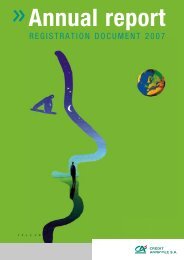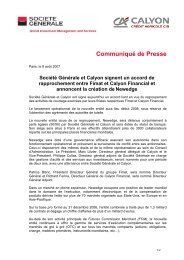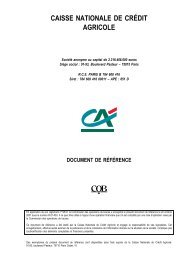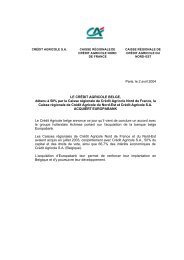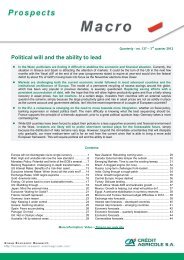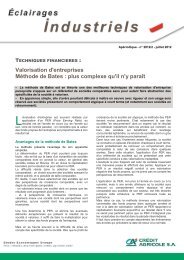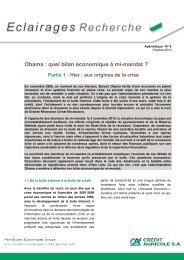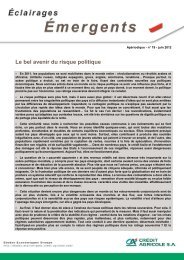PDF (3.77 Mo) - Le Crédit Agricole
PDF (3.77 Mo) - Le Crédit Agricole
PDF (3.77 Mo) - Le Crédit Agricole
You also want an ePaper? Increase the reach of your titles
YUMPU automatically turns print PDFs into web optimized ePapers that Google loves.
Crédit <strong>Agricole</strong> S.A.Update of the 2011 registration document - A03ARTICLE 34 – DISSOLUTION – LIQUIDATION1. The Company shall be in liquidation as from the time that it is dissolved, for any reasonwhatsoever. Its legal personality shall subsist for purposes of such liquidation and until completionthereof.The Shares may continue to be traded until liquidation has been completed.Dissolution of the Company shall be effective as against third parties only as from the date on whichthe notice of dissolution is published in the Paris Trade and Company Registry.At the end of the life of the Company or if it is dissolved in advance by an Extraordinary GeneralMeeting of Shareholders, said Meeting shall fix the rules governing liquidation. Voting in accordancewith the quorum and majority voting requirements applicable to Ordinary General Meetings, it shallappoint one or more liquidators whose powers it shall determine, and who shall carry out theirresponsibilities in accordance with the law. Upon appointment of the liquidators, the functions of thedirectors, the Chairman, the Chief Executive Officer and the Deputy Chief Executive Officers shallcease.Throughout the duration of liquidation, the General Meeting and the Special Meetings of Shareholdersshall continue to exercise the same powers as they did during the life of the Company.2. The liquidator shall represent the Company. He shall be vested with the broadest powers todispose of its assets, even informally. He is authorised to pay creditors and distribute the remainingbalance.The General Meeting may authorise the liquidator to continue pending business or to undertake newbusiness for the purpose of the liquidation.3. In the event of the Company’s liquidation, the Preferred Shares shall rank pari passu amongstthemselves and with the Ordinary Shares as set forth below.After all of the Company’s liabilities have been settled, the Preferred Shares and the Ordinary Sharesshall have identical rights to the net assets, proportional to the percentage of Notional Capitalrepresented by each class of Shares, and, with respect to the Preferred Shares in each class, up tothe amount of their Adjusted Issue Price (as defined in Article 6, “Share Capital” of the Articles ofAssociation).The par value of the Ordinary Shares and of the Preferred Shares shall be reimbursed proportional totheir share of the Company’s share capital, and any liquidation dividend shall be distributed, such thatthe principle set out in the foregoing paragraph is observed, and, for all of the foregoing, and withrespect to the Preferred Shares, up to the Adjusted Issue Price.ARTICLE 35 – DISPUTESCourts having jurisdiction under Ordinary law shall resolve any dispute which may arise during the lifeof the Company or during liquidation following dissolution, either among the Shareholders, themanaging and governing bodies and the Company, or among the Shareholders themselves, inconnection with corporate business or compliance with the provisions of the Articles of Association.Page 231 sur 237



